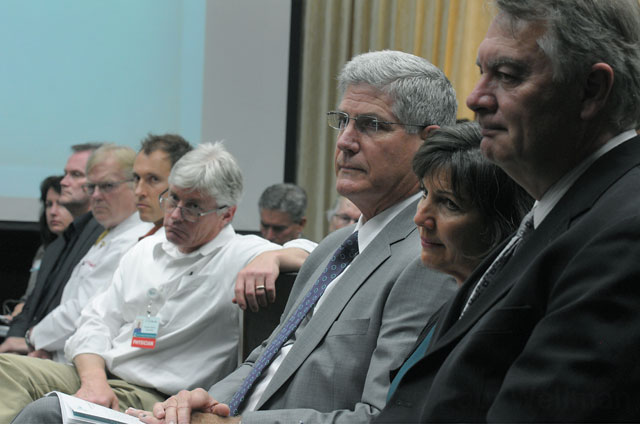Cottage Hospital and Its Discontents
Noisy Kids and Trucks — Not Copters — Rouse Wrath of Neighbors

When Cottage Hospital CEO Ron Werft showed up at City Hall Tuesday backed by a sizable posse of high-powered administrators and medical professionals — some wearing white lab coats — it seemed a case of overkill. But when the dust settled, it was evident Werft should have brought more. Not only was Cottage blistered by a handful of neighbors abidingly angry because of the noise and disruption they charged the new and improved hospital has wrought, but the City Council — normally loath to get sideways with Cottage — appeared to take the neighbors’ concerns to heart. “Go forth,” Councilmember Bendy White instructed Werft at the meeting’s end, “and try to be as compatible as you can.”
Werft showed up to give the council an update on helicopter traffic. During the first week that Cottage’s new helipad became operational this February, there were 13 helicopter trips; five came bearing patients in just one night. The environmental impact report for the Cottage master plan—approved in 2005 — predicted a maximum of a two such trips a week. The neighbors freaked, but legally, there was nothing City Hall could do. Besides, much of the traffic was generated by Cottage’s new state-of-the-art stroke treatment center; the hospital was saving lives.
Since that first week, Werft reassured the council, copter traffic has dropped to a more manageable level — just 2.4 trips a week. Of the 38 helicopter ambulance deliveries, 20 were stroke victims, nine trauma patients, and eight critically ill kids. Werft pointed out that Cottage had laid down the law with the 18 helicopter services statewide — absolutely no orbiting. In fact, Cottage terminated one contractor. But Werft got an inkling he was in for bumpy ride when Councilmember Cathy Murillo acerbically asked — in response to the one-minute soundless video Werft showed of a helicopter landing on the Cottage helipad — “Was the microphone broken on the video camera? We didn’t hear the audio.”
But that noise proved the least of the neighbors’ concern. “The helicopter noise is nothing compared to what we put up with every day,” declared a woman who lives next to the hospital’s nationally acclaimed and award-winning day-care center. For her and her husband — who also testified — life had become a living hell of incessantly screaming and yelling day-care kids. Why was there no sound wall, she demanded. And why did City Hall allow Cottage to build a two-story playhouse that looked directly into their bathroom?
Efforts to get help either from City Hall or from Cottage proved fruitless; Cottage administrators, she claimed, failed to show up for one meeting. “We’d just like some help,” she said. Another man, Ivan Girling, complained of trucks backing into Cottage’s new loading dock — now located directly across the street from his house — as early as 4 am. And Beth Bailey who lives on the 500 block of West Junipero Street, asked the council to rezone her home from residential to commercial. That way, she explained, she’d be able to sell her property. Yes, she said, the helicopters make her windows rattle and her house shake, but it’s the constant delivery truck traffic that’s really changed her family’s life. Two years ago, she said, she put the house on the market; the only interest came from a doctor thinking about opening an office.
City planning director Bettie Weiss said she’d met with many of the neighbors, but given Cottage’s Planning Commission approval, there was little that could be done. “I feel the explanations we’ve given haven’t been what the people wanted to hear,” she said. Werft declined to respond to complaints about the day-care center, explaining he’d only just heard about it. He insisted Cottage had been extremely responsive neighborhood concerns, pointing out that during construction of the biggest development in Santa Barbara’s history, City Hall had received only 10 phone calls of complaint.
With five years of construction completed, Cottage has another five to go before the massive renovation effort is done. “The most disruptive part of this project is behind us,” he declared, adding that the only people the council hadn’t heard from were “the 38 patients whose lives have been saved.” Of the councilmembers, Murillo was perhaps most outspoken. “Be an excellent neighbor,” she told Werft, “not just a good neighbor.”


